Tuesday through Sunday from 12:00 until 21:00
Closed Monday
Admission is Free

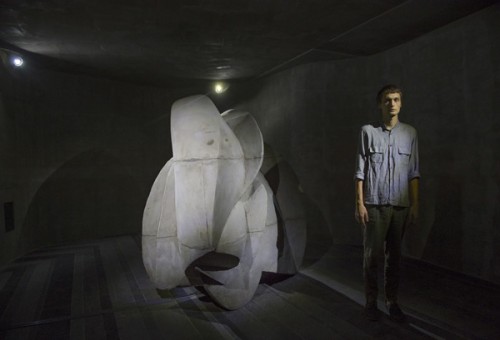
Tatiana Kochubinska: You are a fifth-generation artist, which means your choice of profession may have been predetermined. Nevertheless, what did you think about the idea of reconsidering your artistic practice in connection with the analysis of your predecessors’ experience?
Ivan Svitlychnyi: I think that Re-Consideration is a relevant and interesting project, especially interesting for Ukraine, because information about many artistic generations has been lost. Thus, addressing the question of interconnections and continuity is very important. Personally, I have never rejected previous generations or wished for a radical revolution. The history of generations is a question that has always interested me, not explicitly, but rather staying with me on subconscious level.
TK: You are one of the few Ukrainian artists working with sound. It would be really interesting to learn, in the context of reconsideration, how you became interested in it?
IS: I do not treat sound as a goal, I do not work with sound for the sake of the sound itself. It is an instrument, just like drawing, painting, sculpture, theater etc. It is important for me to seek the realization of my inner conception which incorporates many elements, issues, and challenges. At some point sound became the most suitable means. Over time it has turned into an experience, since I have to learn and understand the selected tool. Until one masters the instrument, it is impossible to use it.
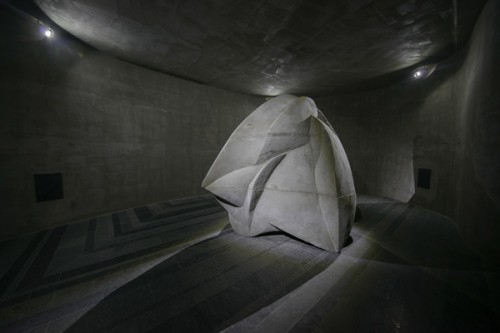
TK: It seems to me that sound was more of an experiment for experiment’s sake in your previous works where the main goal was to find a certain ‘soundform' and achieve an awareness of form through sound. In ‘Subimage’, on the other hand, sound and form are generated from a unified digital stream, they are equally important in creating image as a whole.
IS: Yes, these projects are different. I would like to reiterate, though, that I do not work with sound for the sake of sound alone, I do not perform experiments for experiments’ sake. In my previous projects sound functioned as a universal tool that can overcome the dominance of visual image and, as a result, solve further problems. In my new work audio, form, and exposition form a single image together.
TK: Going back to the idea of reconsideration: all exhibitions within this project are very different. How did the recognition of influences and their transformation into a visual image occur in your case?
IS: Having started the work, I realized that I could not formulate just one single factor. In my situation there is a huge image of influences, a multi-dimensional array within which I exist, and which for this very reason I cannot fully understand.
Then I reformulated this question in a more concrete way: what can be singled out of this array?
How can I create a model that would help to understand the entire image? And at the time I already tried to establish those immutable, stable elements (such as milieu, teachers, family) which had been a core to my formation and which consequently served as the basis of this project.
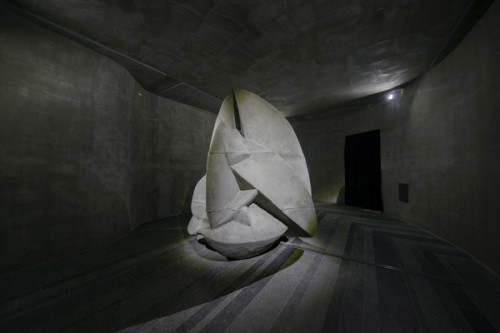
TK: That is to say, ‘Subimage’ represents a reconsideration of your identity founded on the analysis of artistic environment, teachers, and family.
IS: Yes, it was actually the study of these basic elements – lines – that formed the foundation of the installation. Bacteriological and genetic research was conducted, and I also analyzed the painting The Greek Massacre created by my father, Yevgeniy Svitlychnyi, together with Volodymyr Shaposhnikov. The obtained results were then transformed into six digital streams. Streams are converted into form and sound in the Subimage installation. Those elements which shaped me from the outside – the picture, biographical dates, my father’s gene – predetermined the form of the sculpture.
TK: In what way?
IS: For example, I see a stream of numbers, and I can configure it in space, reflect on it and model parameters according to which these figures will be generated into form and sound. Formally speaking, DNA analysis results already provide us with X- and Y-axes– they are X- is and Y-chromosomes. And Z-axis is represented by locus. These parameters have become the foundation for the formation of the sculpture, its main points in space. Then there is another stream of numbers – dates taken from my biography. The curved lines connecting the main points of sculptures are formed by these dates. The Greek Massacre painting has also been digitalized; it specifies material tension applied to the "dates and gene" framework.
As to sound, it is based on my gene and on bacteriological analysis. The sound permeates the sculpture constructed from my father’s gene and dates.
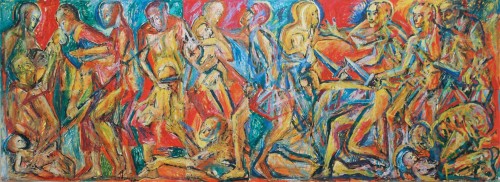
Eugene Svetlichny. Vladimir Shaposhnikov. Massacre in Greek. The late 1990s, paper, oil, enamel, 240 x 420 cm
TK: Could you talk about each of the lines? How, for example, were the places and dates chosen?
IS: Places were predetermined by dates, while dates represent the most memorable and hence the strongest artistic impressions. There are a lot of these. For example, the opening of Volodymyr Shaposhnikov’s and Yevgeniy Svitlychnyi’s exhibition 1 + 1 = 1. Or the day when I first came to Volodymyr Sergiyevych Kochmar’s studio. However, the line also includes moments from the time I am not conscious of, the time about which I was told post factum.
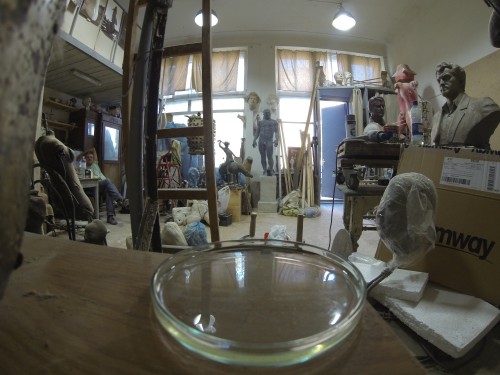
Workshop of Kochmar
TK: Was there some kind of limit imposed on the number of places and dates, as influence is an ongoing process?
IS: Number 17 is central to the work, since 17 DNA regions are analyzed. Therefore, there are 17 dates and 17 places respectively.
TK: What are these places?
IS: For instance, 9a Culture street – sculpture workshops, House of Artists, "Energetik" culture centre affiliated with CHPP #3, the institute, home.
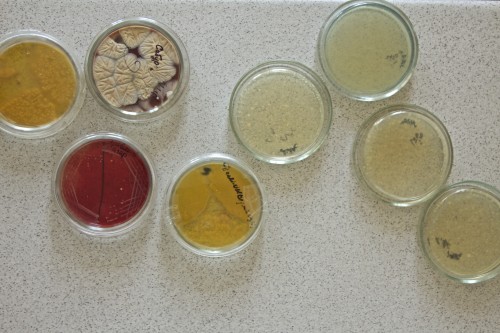
Bacteriological analysis
TK: Tell us about your teachers. Is their influence embodied in the picture which connects you to your milieu? If there were a lot of teachers and works, how did you manage to choose one picture?
IS: After all, I was creating a work of art rather than conducting scientific research. Consequently, it was important to identify the limits within which artistic image is not yet lost. For me, this picture represents the interrelationship between gene and environment; also, it is a really powerful childhood impression. The opening of the exhibition where it was first exhibited is a very bright, clear memory.
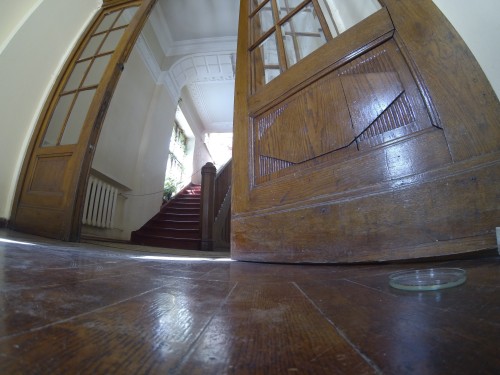
Kharkiv House of Artists
TK: That is, all the transformed digital streams create an image of you as seen through the chain of mutual influences and interrelationships. This image is based on external factors (father’s gene, dates, the picture) as well as internal ones – such as your reflection upon these external conditions.
IS: Yes and no. This image is what I am insofar as any work of art is the image of the artist. Dates, my father’s gene, and the picture that testifies to the influence of teachers all contributed to shaping the form. My gene and places are involved in the formation of sound, which, in my view, is more volatile. I see another person as something more stable, whereas my own self – as changeable, volatile. By volatility I mean here a huge bulk of thought inside my head. There is the same bulk inside other people, but I cannot see this, I can only assume it to be true, so in this sense ‘the other’ is stable for me.
Therefore, in this work sound, which is a movable structure, represents me, while the sculpture embodies constant factors.
TK: In addition, there is also external sound. How is it formed?
IS: It is formed on the basis of my artistic analysis of the painting – how I see and understand it. Relying on this analysis, I made a set of patterns. For example, I mark some color patches, a certain composition or a storyline etc that I see as important. The resulting patterns, ready to be converted into an audio stream, are loaded into a program which already has a virtual room – an exact model of the exhibition space. The virtual room also has an 4:0 audio system analogous to the real system used for the exhibition. This audio system model distributes the sound in such a way that every pattern is eventually represented by sound in real exhibition space.
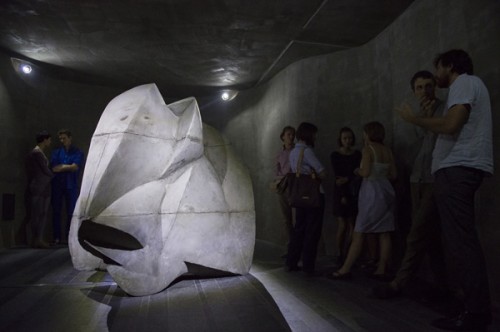
TK: Does not the inner sound of the sculpture destroy this tentative pattern formed by external sound?
IS: No – different frequencies are used. External sound is the bass sound, whereas the sound inside the sculpture belongs to high and middle register. Bass can be felt on physical level. It is important that the picture created with bass, its vibration, should be perceived physically.
TK: How do these audio streams interact in real time? Do they develop?
IS: Yes, they do. As I have already mentioned, the most powerful point of reference in this project is constituted by the DNA analysis of 17 gene sites. Therefore, there are 17 repeated audio frames. However, they are created anew each time, that is, no recording is used. The duration of each period is determined by the correlation between my gene and the gene of my father at a certain interval. It is of major significance that the whole recurring cycle is not recorded. A specifically designed algorithm provides the generation of sound as it is played again and again. This live aspect of sound ensures its uniqueness.
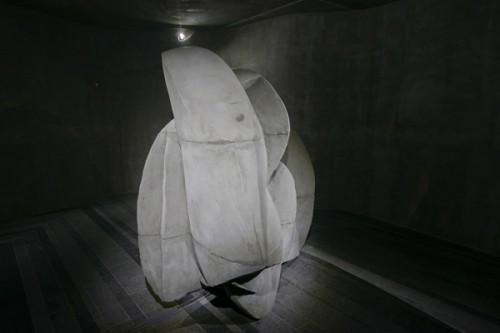
TK: That is, this mode of sound generation produces different sound periods?
IS: Everything is played live, but changes are hardly perceptible. There are numbers that form a very rigid stable structure. The sound is partially stable, because there always is ephemeral distortion as the sound passes through material in space.
TK: Why did you decide to show the influence of environment, family and teachers with the help of scientific research?
IS: I wanted to obtain results that would be as undistorted as possible. When the image is still in imagination, in someone’s consciousness, thought, it is ideal, but as soon as it comes into contact with the outer world it undergoes severe distortion. In order to "remove" this object from my head without changing it I decided to resort to research and analysis as the most appropriate instruments here.
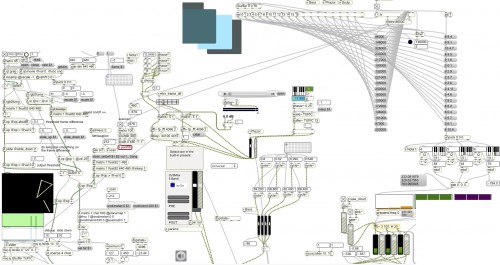
Sound programming
TK: Thus, the scientific part of the project is an instrument. Is it important for you that the viewer should understand the whole process, step by step – or will it be enough if the viewer understands the end result?
IS: I would like to explain this with an image: we see the tree as a whole, and this may suffice. There is a whole, indivisible image. Yet, upon establishing that the tree has a trunk, branches, leaves, and cell structure serving as its basis, we are able to understand how it has been formed. This is also true here. It is important that there is a completed art object perceived by the viewer from his or her viewpoint. If the viewer wants to know how the object has been formed, he or she can read about it, listen to an interview, or simply meet with its author. I lot upon the viewer’s inner work, inner knowledge, inner experience. The viewer is a completely different machine of perception. As soon as he or she begins to think in author’s terms, everything starts to collapse. People can only rely on personal images and experiences, they cannot use the categories of someone else’s perception, because this kind of analysis is ineffective. The image can only be perceived through one’s own perspective.